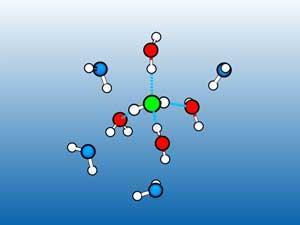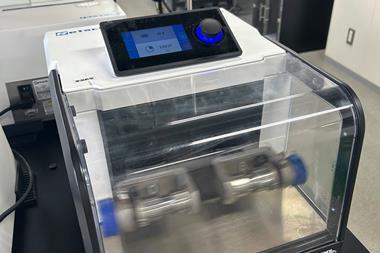Water trapped between graphene sheets transformed into new type of ice
Water may be the most abundant substance on the planet’s surface but it continues to throw up surprises. The latest discovery is that sandwiching water between two sheets of graphene leads to it freezing at room temperature to form two-dimensional square ice crystals, a hitherto unknown phase of ice.
Previously, 17 phases of stable ice were known to exist – all with their own characteristic molecular arrangement, packing density and symmetry. Unusually, the newly discovered square ice has a symmetry that’s completely alien to water molecules and different from all other known ices.
‘Materials often behave differently at the nanoscale – water is a particularly interesting substance and is known to be ubiquitous at interfaces and in microscopic pores,’ says Irina Grigorieva, who led the research at the University of Manchester, UK. ‘In fact, a few monolayers of water cover every surface around us, even in the driest deserts, and fill in every single microscopic crack.’
For decades, scientists have tried to understand the structure and behaviour of water confined in such tiny spaces. Theory suggests many possible phases of water but imaging techniques to determine their crystal structure were lacking. Instead, researchers relied on computer simulations, which often gave conflicting results.
‘This study was stimulated by our previous observations of ultrafast flow of water through graphene nanocapillaries that form in membranes made from graphene oxide,’ explains Grigorieva. ‘We even speculated that water in those capillaries must have formed a correlated two-dimensional structure – room temperature ice. Now we can see this ice directly.’
When a tiny drop of water was sandwiched between graphene layers, most of it was squeezed out by van der Waals forces, but a little was trapped. Since graphene is transparent to electron microscopes, and its hydrophobicity prevents water interacting with it, the team could use transmission electron microscopy (TEM) to image the water’s oxygen. This revealed that the water molecules were uniformly arranged – characteristic of ice – into a square lattice.
‘It is fascinating that water still harbors many unknowns and surprises,’ comments Vitor Pereira, who investigates two-dimensional materials at the National University of Singapore. ‘This can be an important first step towards a new field of research concentrated on a more systematic understanding of the structure, properties and dynamics of water at the nanoscale, be it confined in nano-crevices or as a molecularly thin surface layer atop other crystals or solid materials.’
By better understanding how water behaves at the molecular scale, such as the ultrafast flow of water through graphene-based membranes, Grigorieva thinks it could help improve the efficiency of filtration, desalination and distillation technologies.












No comments yet